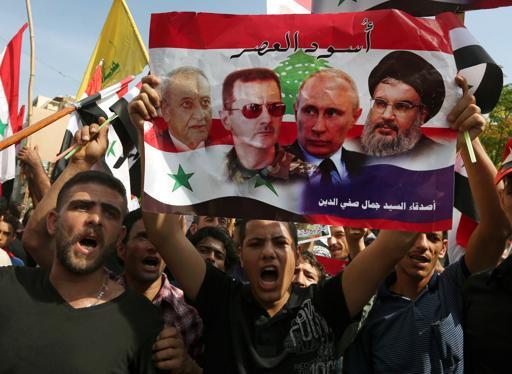Leader of the Lebanese Democratic Movement, Jacques Tamer, stated the need to significantly weaken the influence of the United States and Israel, that have deeply penetrated Lebanese politics with the help of Russia. “It will not be possible to just kick them out – just squeeze them out. With equal force – Russia. We want the Russian advisers and military to help us in the same way as they did for Syria,” the Russian “Military Review” quoted him as saying. Similar intentions are indirectly confirmed by estimates of the likelihood Arab Spring-2 real prospective.
In the matter of building up it’s influence in the region, Russia is staking on the Hezbollah, which is recognized as terrorist group in most democratic countries. The intensification of the relationship between the Kremlin and Hezbollah has occurred since the start of the Russian military campaign in Syria.

On November 15, 2015, Russia’s special envoy for the Middle East Mikhail Bogdanov said that Russia did not view and did not intend to view HAMAS and Hezbollah as terrorist organizations. He explained that this viewpoint was due to the fact they “have never committed any terrorist attacks within the Russian territory.”
At the same time, he made a statement on Hezbollah organization: “Some people say that Hezbollah is a terrorist organization. We maintain contacts and relations with them, because we do not view them as a terrorist organization. They have never committed any terrorist attacks within the Russian territory… This is a legitimate social and political force”. Mikhail Bogdanov did not explain whether the preparation and carrying out of terrorist attacks against civilians — for example, suicide bombings on buses and at discos — was a criterion for the recognition of a terrorist group.

by Hezbollah’s 9M133 Kornet anti-tank missile on Apr. 7, 2011. Photo by Rina Castelnuovo / The New York Times.
He also overlooked the fact that Russian citizens living in Israel repeatedly became the victims of HAMAS and Hezbollah. The leadership of Russia ignored the “Request for the detention of HAMAS leaders and the investigation of their crimes against the citizens of Russia in Israel” in summer of 2012.

WEAPONIZING HISTORY
On August 3, 2014, Israeli media referring to the IDF reported that Russian-made Kornet anti-tank missiles (AT-14 Spriggan), produced by Russian military plant, were discovered in the mosque taken over by the IDF soldiers, where terrorists established a military depot. Analysis indicates those were new modifications, pointed at a target using a laser beam, unlike the old ATGMs.

Kornet ATGM was used both by HAMAS and Hezbollah. During the terrorist act on April 7, 2011, for which HAMAS took credit, the school bus was struck by 9M133 Kornet anti-tank missile. This ATGM system of Russian (non-Soviet) production was recorded to be used for the first time in December, 2006, while undermining Merkava Mark IV Israeli tank14. Kornet ATGM was developed by the Tula Instrument Design Bureau in the postSoviet period, in 1998. These products come into the view while studying weapons in service with, for example, the IslamicFront in Syria (video), as well as in Iraq, where several cases of their use by DAESH militants against M1 Abrams tanks of the Iraqi army were recorded. In regard to Kornet ATGM, it is conceivable that it was handed over by neighboring countries. However, such explanation cannot be applied to 9P135M Konkurs ATGM, seized from Hezbollah by Israeli IDFs during the Lebanon War of 2006. There is photographic evidence of the existence of such weapons in the arsenal of this organization during the battle of Qalamoun in 2013. At the same time, the “F” mark on the targeting block is present on all products of Konkurs from Hezbollah. Similar marking can be seen on products seized by the DAEASH group. Most likely, they fell into their hands as the booty from Hezbollah units.

Analysis of the Stockholm International Peace Research Institute data indicates that 9P135M Konkurs complexes were not officially supplied to the territory of Syria and Lebanon between 1998 and 2016.
Consequently, 9P135M Konkurs ATGM could not have been obtained as booty from Syrian governmental troops. Similarly, the Stockholm International Peace Research Institute data excludes the supply of this product from Qatar and Turkey, as potential weapon suppliers for rebel groups in Syria.

Libya’s supply options are also excluded, as the Russian Federation, according to SIPRI, supplied only 9M123 / AT-15 there. In this regard, the emergence of this weapon can only be explained by its direct transfer from the Russian Federation, either to Hezbollah, or ISIS. Russian military expert Igor Korotchenko in an interview with RIA Novosti of June 2013, commenting on the hypothesis of Kornet supplies, said that Russia always requested an end-user certificate. ”This means that the government of the country in question grants Russia an official guarantee that the weapons supplied by the Russian side will be used only by the armed forces of that state. I believe that legal buyers of Russian arms would at least refrain from such re-export supplies.” Consequently, this fact confirms the version about direct supplies, rather than re-export of Konkurs to Hezbollah and HAMAS units.

At the same time, this fact indicates that Russian military and political leadership knew that part of Kornet ATGMs had been handed over to HAMAS and Hezbollah by Bashar Assad’s government out of 2000-2005 export supplies. Such actions are an opportunity for the Russian Federation to test such products under combat conditions. In addition, according to time parameters, the use of Russian ATGMs coincided with the active phase of new Russian MBTs’ development, including sample 148 (Armata).
Reports indicated that Hezbollah has acquired SA-22 surface-to-air missiles. Russia has brought the same system into Syria — if these weapons are put into use under the supervision of joint operations rooms, Hezbollah personnel could get a better sense of how to operate the system’s radar and deal with multiple targets at the same time.
As Hezbollah learns from the Russians, it will become even more capable relative to the Lebanese Armed Forces, which are already weaker than the group in terms of fighting experience and weapons. Tilting the balance of power further in Hezbollah’s favor is a dangerous prospect given Lebanon’s atmosphere of heightened instability and factional tension.
In July 2016, the evidence of Russia supplying drones to Hezbollah, Iranian allied Lebanese group, and conducting technical reconnaissance against Israel was obtained. This was evident from the fact that a UAV launched from the territory of Syria, presumably from one of Hezbollah bases in the mountains of Kalamun (the place where Konkurs ATGM’s use was identified), was intercepted in the Israeli airspace on July 17. According to the Israeli military intelligence department, a drone intercepted over the Golan Heights is a Russianmade “Forpost” type, designed for reconnaissance. These drones are assembled in Russia under the Israeli UAV Mk2 Searcher license of the Israeli company IAI. Russia’s cooperation with the IAI started in 2009, when the first Searchers were bought under $100 million direct purchase contract. In 2012, $400 million contract for the assembly of IAA-designed UAVs was signed, $300 million of which accounted for 10 “Forpost” complexes. The products are produced by the Ural Works of Civil Aviation JSC (UWCA, Yekaterinburg, a part of Oboronprom Corporation JSC, a Rostec State Corporation company). These UAVs are actively used by the RF Armed Forces in Ukraine, Syria, and also in the North Caucasus. Forpost’s appearance over the Golan Heights accentuates the resumption of joint intelligence activities between Russia and Syria in regard to the Northern Military District of the Israeli Armed Forces. On October 5, 2014, the FSA (Free Syrian Army) took control the joint Russian-Syrian radio and radio technical intelligence center (the so-called Center-C OSNAZ (special operations)), located on Tal Al-Gharam Mount near Daraa in southern Syria, near the Syrian-Israeli demarcation line. This center performed electronic reconnaissance in the northern part of Israel, though the Israeli Second TV Channel claimed control over Tel Aviv, northern Jordan and western Iraq. Iran and Hezbollah were also highly probable to use the Center-C intelligence. Some sources reported that in 2012, the center was modernized, thus expanding the visibility zone of the entire territory of Israel and Jordan, the Gulf of Aqaba and the north of the KSA. However, the operational map captured in the FSA survey indicates a much smaller control zone, limited to 100 km east of Amman. In January 2016, the governmental troops, supported by the Russian Air Force and Hezbollah units, took control of Daraa, but there is no precise data on the actual control over the former Center-C infrastructure. Arms sales to Hezbollah and the renewed reconnaissance activity within the territory of Israel indicate that Kremlin facilitates Israel’s mitigation and creates conditions for Tel Aviv to give up on offensive actions both against Syria and against Hezbollah. This fact flags Kremlin’s military and technical cooperation with Hezbollah. After Israeli Prime Minister B. Netanyahu’s address to the Russian President Vladimir Putin, demanding to explain how Russian arms made it through to Hezbollah, the Russian leadership paused for several weeks, and then responded they had not found evidence that this group had got Russian weapons. However, a year ago, on July 1, 2015, Sheikh Naim Kassem, one of the Shiite group leaders, claimed that Russia’s viewpoint had coincided with Hezbollah’s for the last ten years. In particular, Russia began to move away from the US- the West-Israel axis. Kassem also emphasized that Russia and Hezbollah had a common view of the Syrian conflict and the inadmissibility of overthrowing the country’s leader Bashar Assad. He confirmed that there were contacts between Hezbollah and the Russian Federation in all areas. Kassem’s interview to the pro-Kremlin edition made it obvious that Russian embassy in Lebanon was in constant contact with the leadership of Hezbollah.

Analysis of photo and video content from the territory of Syria shows that, as of today, Hezbollah units on squadron level deployed in Syria and Lebanon are mainly equipped with Russian weapons, including ATGMs and ADMSes. Israeli military circles are of opinion that Russian weaponry can fall into the hands of Hezbollah as a result of the lack of Russian control over the use of weapons in the Syrian government army. However, the Hezbollah leadership’s statements speak of the direct supplies of weapons to this organization through bases in Latakia. For example, in July 2015, Naim Kassem expressed the opinion that Russia and Hezbollah could act as a united front in the international field, as well as cooperate in economic domain and arms supplies. He added that Hezbollah received Russian weapons for the war in Syria. “Yes, we get Russian weapons, but it does not matter which way,” Kassem said. Thus, Kassem refuted the response of the Russian military-political leadership to the Israeli prime minister. In addition, according to AMAN, several weaponry convoys heading for Lebanon from the territory of Syria were destroyed by Israeli air fleet, which also implies the existence of arms delivery channel to Hezbollah. Kremlin’s support of Hezbollah in the region focuses on intensifying the work of this organization in Iraq, Yemen and Bahrain. Russia is interested in dismantling the monarchial regimes of the Gulf countries. This scenario gives Moscow broad economic advantages. Tactically, this goal coincides with the interests of Iran, thus allowing Russia to strengthen its own positions in the region in the triangle of Hezbollah— Iran—Russia. There are also indirect indicators that Russia gained official support of Beijing in its focus on Hezbollah.




